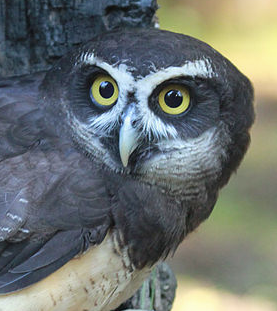We're open daily! View holiday hours
Science News
Head-Spinning Birds
February 1, 2013

How do owls spin their heads? Why do some pigeons sport fancy hairdos? And how do homing pigeons get home? We’re not joking—these are the latest science headlines!
If we tried to turn our heads like owls, we’d die. It’s that simple. Sudden gyrations of the head and neck in humans have been known to stretch and tear blood vessel linings, producing clots that can break off and cause a deadly embolism or stroke.
So medical researchers and illustrators at Johns Hopkins decided to find out how owls can rotate their heads up to 270 degrees in either direction. Using several previously frozen dead owls, the team injected contrast dye into the birds’ blood vessels, which were then meticulously dissected, drawn, and scanned to allow detailed analysis.
The team discovered four major biological adaptations that help prevent injury from rotational head movements in the owls. Variations to the animals’ bone structure and vascular network support its top-heavy head.
The owl illustrations won first-place in the posters and graphics category of the National Science Foundation’s 2012 International Science & Engineering Visualization Challenge.
We have to go to the salon for a fancy hairdo, but for some breeds of pigeons, it’s all in the genes! “There are some 350 [pigeon] breeds with different sizes, shapes, colors, color patterns, beaks, bone structure, vocalizations and arrangements of feathers on the feet and head—including head crests that come in shapes known as hoods, manes, shells and peaks,” says Michael D. Shapiro of the University of Utah.
Shapiro led a team of researchers who sequenced the genomes of several different breeds of pigeons and found a single mutation in a gene named EphB2 that causes head and neck feathers to grow upward instead of downward, creating head crests. And the diversity in crests is amazing, says Shapiro. “Some are small and pointed. Others look like a shell behind the head; some people think they look like mullets. They can be as extreme as an Elizabethan collar.” This research appears in the current issue of Science.
Homing pigeons certainly use compass-like techniques to find their way, but that doesn’t entirely explain their homing skills. U.S. Geological Survey scientist Jonathan Hagstrum was curious, why, for instance, tens of thousands of pigeons were lost in a 1997 race that crossed paths with the Concorde.
Hagstrum believes that homing pigeons also use infrasound—a low-level sound that many animals, but not humans, can detect. The birds make a kind of mental map from the sounds. According to Science Now:
Infrasound is generated when deep ocean waves send pressure waves reverberating into the land and atmosphere. Infrasound can come from other natural causes, such as earthquakes, or humanmade events, such as the acceleration of the Concorde. The long, slow waves move across vast distances.
You can find this research (without an infrasound map, alas) at The Journal of Experimental Biology.
Spinning, cresting, and finding home… We hope you enjoyed this bird’s-eye view of recent research headlines.
Image: DickDaniels/Wikipedia